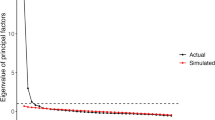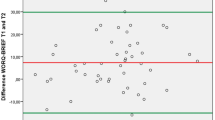Abstract
Purpose Musculoskeletal disorders (MSDs) are often associated with long-term sick leave, productivity loss, and reduced work functioning. However, measures that assess work-related functioning are sparse. Objective To assess the psychometric properties of the Work Rehabilitation Questionnaire (WORQ)-German version in patients with MSDs in an outpatient physical therapy practice. Methods Psychometric study including patients with MSDs with restricted work participation. Data was collected in a single physical therapy outpatient clinic. For construct validity, we developed a priori hypotheses on the correlation between the functioning part of WORQ (40 items) and other questionnaires with similar concepts. For test–retest reliability, WORQ was administered twice, 7 days apart. We examined internal consistency (Cronbach’s Alpha) and Minimal Detectable Change (MDC). Feasibility of WORQ was examined using feedback from patients and physical therapists. Results There were 51 study participants. Test–retest of WORQ sum score was 0.80 (p < 0.01) (Spearman’s rho). Internal consistency was 0.94 and MDC established at 9.2%. WORQ correlated with general health (r = − 0.49), with HADS (r = 0.55), and with quality of life (WHOQOL) (r = − 0.47). WORQ had the highest correlation with WHODAS 2.0 (r = 0.81). Patients rated WORQ as easy to answer and meaningful to their experience. Conclusions When evaluating self-reported work-related functioning, the WORQ-German version was demonstrated to be a valid, reliable, and easy to administer questionnaire for our sample of patients with MSDs in an outpatient PT clinic.
Similar content being viewed by others
References
Waddell G, Burton AK, Kendall NA. Vocational rehabilitation: what works, for whom, and when? London: The Stationary Office; 2008. http://www.kmghp.com/assets/hwwb-vocational-rehabilitation.pdf. Accessed 25 Jan 2018.
Bachmann N, Burla L, Kohler D. Gesundheit in der Schweiz –Fokus chronische Erkrankungen Nationaler Gesundheitsbericht 2015. Bern: Horgrefe Verlag; 2015.
Roelfs DJ, Shor E, Davidson KW, Schwartz JE. Losing life and livelihood: a systematic review and meta-analysis of unemployment and all-cause mortality. Soc Sci Med. 2011;72(6):840–854.
Selander J, Marnetoft SU, Bergroth A, Ekholm J. Return to work following vocational rehabilitation for neck, back and shoulder problems: risk factors reviewed. Disabil Rehabil. 2002;24(14):704–712.
EULAR Position Paper on Health and Safety at Work: Fighting rheumatic and musculoskeletal diseases together [database on the Internet]. 2018. https://www.eular.org/myUploadData/files/eular_position_paper_on_health_and_safety_at_work.pdf. Accessed 14 Feb 2018.
United States Bone and Joint Initiative (USBJI). Opportunities for action—the impact of musculoskeletal disorders on americans. Rosemont: USBJI; 2016.
OECD, HM. The Next Generation of Health Reforms: Ministerial Statement. Paris: 2017.
Nutzi M, Trezzini B, Medici L, Schwegler U. Job matching: an interdisciplinary scoping study with implications for vocational rehabilitation counseling. Rehabil Psychol. 2017;62(1):45–68.
Escorpizo R, Reneman MF, Ekholm J, Fritz J, Krupa T, Marnetoft SU, et al. A conceptual definition of vocational rehabilitation based on the ICF: building a shared global model. J Occup Rehabil. 2011;21(2):126–133.
Kaech Moll VM, Escorpizo R, Portmann Bergamaschi R, Finger ME. Validation of the comprehensive ICF core set for vocational rehabilitation from the perspective of physical therapists: international delphi survey. Phys Ther. 2016;96(8):1262–1275.
Boucaut R. International Federation of Physical Therapists working in Occupational Health and Ergonomics (IFPTOHE). WCPT. 2019. https://www.wcpt.org/IFPTOHE. Accessed 31 May 2019.
WCPT. The International Classification of Functioning, Disability and Health. [updated 10/2016]. https://www.wcpt.org/icf. Accessed 31 May 2019.
Escorpizo R, Stucki G. Disability evaluation, social security, and the international classification of functioning, disability and health: the time is now. J Occup Environ Med. 2013;55(6):644–651.
Escorpizo R, Finger ME, Glassel A, Gradinger F, Luckenkemper M, Cieza A. A systematic review of functioning in vocational rehabilitation using the International Classification of Functioning, Disability and Health. J Occup Rehabil. 2011;21(2):134–146.
Selb M, Escorpizo R, Kostanjsek N, Stucki G, Ustun B, Cieza A. A guide on how to develop an international classification of functioning, disability and health core set. Eur J Phys Rehabilit Med. 2015;51(1):105–117.
Finger ME, Escorpizo R, Glassel A, Gmunder HP, Luckenkemper M, Chan C, et al. ICF Core Set for vocational rehabilitation: results of an international consensus conference. Disabil Rehabil. 2012;34(5):429–438.
Chamberlain MA, Fialka Moser V, Schuldt Ekholm K, O’Connor RJ, Herceg M, Ekholm J. Vocational rehabilitation: an educational review. J Rehabil Med. 2009;41(11):856–869.
Finger ME, Escorpizo R, Bostan C, De Bie R. Work Rehabilitation Questionnaire (WORQ): development and preliminary psychometric evidence of an ICF-based questionnaire for vocational rehabilitation. J Occup Rehabil. 2014;24(3):498–510.
Finger M, De Bie RA, Nowak D, Escorpizo R. Development and Testing of an ICF-based Questionnaire to evaluate functioning in vocational rehabilitation: The Work Rehabilitation Questionnaire (WORQ). In: Escorpizo R, Brage S, Homa DB, Stucki G, editors. Handbook of vocational rehabilitation and disability evaluation. Basel: Springer; 2015.
Finger M, Escorpizo R. Homepage: Work Rehabilitation Questionnaire (WORQ). Swiss Paraplegic Research/ICF Research Branch. 2013. [updated December 2017]. http://myworq.org/. Accessed 19 March 2019.
Finger ME, Wicki-Roten V, Leger B, Escorpizo R. Cross-Cultural Adaptation of the Work Rehabilitation Questionnaire (WORQ) to French: a valid and reliable instrument to assess work functioning. J Occup Rehabil. 2018;29(2):350–360.
The EuroQol Group. EuroQol-a new facility for the measurement of health-related quality of life. Health Policy. 1990;16(3):199–208.
Snaith RP. The Hospital Anxiety And Depression Scale. Health Qual Life Outcomes. 2003;1:29.
World Health Organization (WHO). WHODAS-II - disability assessment schedule training manual: a guide to administration. Geneva: WHO; 2004.
Skevington SM, Lotfy M, O’Connell KA. The World Health Organization’s WHOQOL-BREF quality of life assessment: psychometric properties and results of the international field trial. A report from the WHOQOL group. Qual Life Res. 2004;13(2):299–310.
Sangha O, Stucki G, Liang MH, Fossel AH, Katz JN. The Self-Administered Comorbidity Questionnaire: a new method to assess comorbidity for clinical and health services research. Arthritis Rheum. 2003;49(2):156–163.
Finger M, Schwegler U, Escorpizo R. Poster presentation: psychometric properties and factorial structure of the ICF based Work Rehabilitation Questionnaire (WORQ)—French Version. Work Disability Prevention & Integration; Amsterdam 2016.
Finger ME, Escorpizo R, Tennant A. Measuring work-related functioning using the self-reported Work Rehabilitation Questionnaire (WORQ): metric properties based on Rasch analysis. Int J Environ Res Public Health. 2019;16(15):E2795. https://doi.org/10.3390/ijerph16152795.
Solberg TK, Olsen JA, Ingebrigtsen T, Hofoss D, Nygaard OP. Health-related quality of life assessment by the EuroQol-5D can provide cost-utility data in the field of low-back surgery. Eur Spine J. 2005;14(10):1000–1007.
Kirchberger I, Cieza A, Biering-Sorensen F, Baumberger M, Charlifue S, Post MW, et al. ICF Core Sets for individuals with spinal cord injury in the early post-acute context. Spinal Cord. 2010;48(4):297–304.
Zigmond AS, Snaith RP. The hospital anxiety and depression scale. Acta Psychiatr Scand. 1983;67(6):361–370.
Bjelland I, Dahl AA, Haug TT, Neckelmann D. The validity of the Hospital Anxiety and Depression Scale. An updated literature review. J Psychosom Res. 2002;52(2):69–77.
Üstün BT, Chatterji S, Kostanjsek N, Rehm J, Kennedy C, Epping-Jordan J, et al. Developing the World Health Organization Disability Assessment Schedule 2.0. Bull World Health Organ. 2010;88:815–823. https://doi.org/10.2471/BLT.09.067231.
Posl M, Cieza A, Stucki G. Psychometric properties of the WHODAS II in rehabilitation patients. Quality of life research: an international journal of quality of life aspects of treatment, care and rehabilitation. 2007;16(9):1521–1531.
Andrews G, Kemp A, Sunderland M, Von Korff M, Ustun TB. Normative data for the 12 item WHO Disability Assessment Schedule 2.0. PLoS ONE. 2009;4(12):e8343.
Conrad I, Matschinger H, Riedel-Heller S, von Gottberg C, Kilian R. The psychometric properties of the German version of the WHOQOL-OLD in the German population aged 60 and older. Health Qual Life Outcomes. 2014;12:105. https://doi.org/10.1186/s12955-014-0105-4.
Power M, Quinn K, Schmidt S. Development of the WHOQOL-old module. Qual Life Res. 2005;14(10):2197–2214.
Glassel A, Finger ME, Cieza A, Treitler C, Coenen M, Escorpizo R. Vocational rehabilitation from the client’s perspective using the International Classification of Functioning, Disability and Health (ICF) as a reference. J Occup Rehabil. 2011;21(2):167–178.
Pösl M, Cieza A, Stucki G. Psychometric properties of WHODAS II in rehabilitation patients. Qual Life Res. 2007;16(9):1521–1531.
Renwick R, Nourhaghighi N, Manns PJ, Rudman DL. Quality of life for people with physical disabilities: a new instrument. Int J Rehabil Res. 2003;26(4):279–287.
Field A. Discovering statistics using SPSS. London: SAGE Publicaitons; 2009.
de Vet HCW, Terwee CB, Mokkink LB, Knol DL. Measurement in Medicine: a Practical Guide. Cambridge: Cambridge University Press; 2011.
Mukaka MM. Statistics corner: a guide to appropriate use of correlation coefficient in medical research. Malawi Med J. 2012;24(3):69–71.
Terwee CB, Bot SD, de Boer MR, van der Windt DA, Knol DL, Dekker J, et al. Quality criteria were proposed for measurement properties of health status questionnaires. J Clin Epidemiol. 2007;60(1):34–42.
Brown JD. Standard error vs. Standard error off measurement. JALT Testing & Evaluation SIG Newsletter [Internet]. 1999;3(1):20–25. http://hosted.jalt.org/test/PDF/Brown4.pdf. Accessed 14 Aug 2017.
Tighe J, McManus IC, Dewhurst NG, Chis L, Mucklow J. The standard error of measurement is a more appropriate measure of quality for postgraduate medical assessments than is reliability: an analysis of MRCP(UK) examinations. BMC Med Educ. 2010;10:40. https://doi.org/10.1186/1472-6920-10-40.
Donoghue D, Stokes EK. How much change is true change? The minimum detectable change of the Berg Balance Scale in elderly people. J Rehabil Med. 2009;41(5):343–346.
IBM Corp. IBM SPSS Statistics for Window, Version 25.0. Armonk, NY: IBM Corp; Released 2017.
RStudio Team. RStudio: Integrated development environment for R. Boston: RStudio, Inc.; 2015. http://www.rstudio.com/. Accessed 30 Aug 2017.
Stekhoven DJ, Bühlmann P. MissForest—non-parametric missing value imputation for mixed-type data. Bioinformatics. 2012;28(1):112–118.
Stenner R, Palmer S, Hammond R. What matters most to people in musculoskeletal physiotherapy consultations? A qualitative study. Musculoskelet Sci Pract. 2018;35:84–89. https://doi.org/10.1016/j.msksp.2018.03.005.
Childs JD, Harman JS, Rodeghero JR, Horn M, George SZ. Implications of practice setting on clinical outcomes and efficiency of care in the delivery of physical therapy services. J Orthop Sports Phys Ther. 2014;44(12):955–963.
Hou WH, Tsauo JY, Lin CH, Liang HW, Du CL. Worker’s compensation and return-to-work following orthopaedic injury to extremities. J Rehabil Med. 2008;40(6):440–445.
Bartys S, Frederiksen P, Bendix T, Burton K. System influences on work disability due to low back pain: an international evidence synthesis. Health Policy. 2017;121(8):903–912.
Tavakol M, Dennick R. Making sense of Cronbach’s alpha. Int J Med Educ. 2011;2:53–55. https://doi.org/10.5116/ijme.4dfb.8dfd.
Lerner D, Amick BC III, Rogers WH, Malspeis S, Bungay K, Cynn D. The Work Limitations Questionnaire. Med Care. 2001;39(1):72–85.
Revicki D, Ganguli A, Kimel M, Roy S, Chen N, Safikhani S, et al. Reliability and Validity of the Work Instability Scale for Rheumatoid Arthritis. Value Health. 2015;18(8):1008–1015.
American Physical Therapy Association (APTA). Physical therapist examination and evaluation: Focus on tests and measures. Guide to Physical Therapist Practice 3.0. 2014.
Marfeo EE, Haley SM, Jette AM, Eisen SV, Ni P, Bogusz K, et al. Conceptual foundation for measures of physical function and behavioral health function for Social Security work disability evaluation. Arch Phys Med Rehabil. 2013;94(9):1645–1652 (e1642).
Licher S, Heshmatollah A, van der Willik KD, Stricker BHC, Ruiter R, de Roos EW, et al. Lifetime risk and multimorbidity of non-communicable diseases and disease-free life expectancy in the general population: a population-based cohort study. PLoS Med. 2019;16(2):e1002741.
Acknowledgements
The authors thank all physical therapists at Loewencenter Lucerne for their help with the data collection and the patient/clients for their participation.
Funding
This study was supported by the Swiss Paraplegic Research as part of a Master Thesis.
Author information
Authors and Affiliations
Contributions
AH, MF, RE—Concept/idea/research design. AH, MF, RE—Writing. AH—Data collection, AH, MF—Data analysis. AH, MF—Project management. RE—Consultation (including review of manuscript before submitting).
Corresponding author
Ethics declarations
Conflict of interest
The authors declare that they have no conflicts of interest.
Ethical Approval
All procedures followed were in accordance with the ethical standards of the responsible committee on human experimentation (institutional and national) and with the Helsinki Declaration of 1975, as revised in 2000 (5).
Informed Consent
Informed consent was obtained from all patients for being included in the study. The Ethics Committee EKNZ, Switzerland (Project-ID: 2017-00552) granted full ethical approval of this research study.
Additional information
Publisher's Note
Springer Nature remains neutral with regard to jurisdictional claims in published maps and institutional affiliations.
Rights and permissions
About this article
Cite this article
Husmann, A., Escorpizo, R. & Finger, M.E. Examining Work-Related Functioning in a Physical Therapy Outpatient Clinic: Validity and Reliability of the Work Rehabilitation Questionnaire (WORQ). J Occup Rehabil 30, 156–166 (2020). https://doi.org/10.1007/s10926-019-09857-y
Published:
Issue Date:
DOI: https://doi.org/10.1007/s10926-019-09857-y




